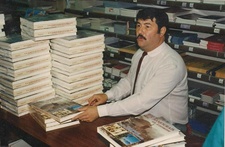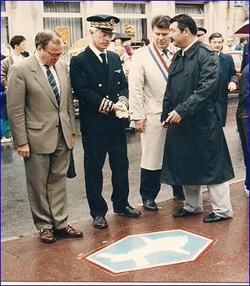I was honored to have lunch with Ted Tsukiyama, retired lawyer and MIS and 442nd historian and James Tanabe, MIS historian. They were both WWII veterans in their late 80s that I had asked to proof my new books. Ted Tsukiyama’s question took me a little by surprise: “Why did you spend so much of your life writing and researching about us (Japanese Americans)?” I believe there are many reasons.
The first thing, of course, is I probably owe my life to the Japanese Americans. They came just in time to liberate my home town of Bruyeres before my father would have been caught for his spying activities as a member of the Office of Strategic Service and one of the leaders of the French Resistance in Bruyeres-in-Vosges (France).
Second, I grew up fundamentally anti-racist and the story of the Nisei fit into my my goals. After all there was such discrimination after the bombing of Pearl Harbor in Hawaii.
Third, I was already the historian of Bruyeres at the age of 16 years old. The battle of Bruyeres and the rescue of the Lost battalion were too big to stay unknown.

There were two big events that made me feel that I had to voice something.
First, in 1971, the first group of veterans of the 442nd RCT came to Bruyeres. In those days, I was one of the few that could speak English and I was probably the only one who knew the history and the emplacement of the big battles in the forest.
I was also the vice-president of the Bruyeres-Honolulu sister city Committee since 1969, so I was designated to guide the 17 survivors of K Company to the battlefields.
442 Company K veterans Munaru Saito, Rudy Tokiwa, Joe Shimamura, Richard Oda, Papoose Sadanaga, Fujio Miyamoto, and others with Fred Kusuno, a teacher from Kaiserslautern in Germany, went with me by bus. I received a special permit to be able to reach the site of the lost battalion location as the road was closed by the Forest and Water Organization in those days.
The group stopped in the flower shop where each of them bought one rose. During the trip on the forest crest I detailed the different battles and the veterans listened to my speech in silence. Then we came to the “Fairy Rock” where the lost battalion was located. Here they all got out of the bus and we all began to spot the different fox-holes still visible at the site. Nothing was there to mark the battle. So they choose to lay their flower under some pine trees. There was evidence of the fighting in the trunks of the trees still covered with bullet holes and shrapnel. All came together and cried silently, cried, cried…
These heroes don’t usually show very much emotion, but the feelings were too strong. They had lost so many friends here, those tears changed my life forever.
Second, in 1977, a group of veterans came from California lead by Kay Ishibashi and Shim Hiraoka. To celebrate the occasion, a film crew from Hawaii with Nino Martin as director made the movie Aloha Bruyeres. We discovered with surprise the story of the internment camps used for the placement of the Japanese Americans in the USA. This took place in the country of Freedom and Justice for all. What a shame!
In 1984, Kay Shory and Ludi Boken from Belbo Film realized Yankee Samurais. When we arrived at Marker Six, one of the eight survivors of I company who reached the Texas lost battalion, Shig Doi, could not keep his tears at bay and hid himself in the bush. Suddenly,he yelled at me from the bushes: “Pierre, please come here!” I jumped in the bushes and at the feet of Shig Doi was a fox hole completely intact with not one leaf inside it just like it was dug yesterday. It was unbelievable! Then Shig Doi, in tears, told me: “So many young boys died here, for what? Nobody will know.” My decision was made and I told him: “Shig, I swear they will know.”

So I proposed to myself three missions that were nothing compared to the one the 442nd RCT faced during the war, but it took me 25 years to fulfill them:
The first mission was to let the people of France know the story of those Nisei Soldiers. I wrote in 1988 the book U.S. Samurais en Lorraine, in French, published by Gerard Louis editions and noted by The President of the Republic of France Francois Mitterrand.
The second mission was to bring as many possible inhabitants of Bruyeres (France) to Honolulu (Hawaii) for them to learn first-hand what Bruyeres means to these Veterans. The Battle of Bruyeres is considered as one of the ten most important battles of the history of the United States and because of the Nisei soldiers’ heroism in Bruyeres they became the most decorated unit in all US History.
I brought the first group of 66 Bruyerans to Hawaii in 1976 for a “Fantalohastic” Visit to Paradise opening the way for many groups in the years after.

My third mission was to imprint on the very Bruyeres soil, the mark of the Battle. I donated to the city a Fountain of Peace and Freedom to be visible in the streets of Bruyeres since the two Memorials erected in Bruyeres—in 1947 by my grandfather Deputy Mayor Charles Etienne and Mayor Gillon and the one in Biffontaine in 1984 by Mayor George Henri and Jean Bianchetti—were located in the middle of the forest.
Walking the freedom trail in Boston in 1969, I dreamt for years to be able to do the same for my heroes. The Bicentennial of the French Revolution and the first presentation of the Bill of human rights to the French Convention gave me the opportunity to realize my third goal. I created and realized the Peace and Freedom Trail marked with 89 plaques retracing the story of each location.
In the meantime, I saved the Jewish synagogue from destruction; it eventually became the Museum Henri Mathieu and told the story of the Japanese Americans to the visitors.
Performing those tasks were not that easy. When I started I was just concerned with keeping the legacy of my heroes alive. When my first son Sebastien was born, I didn’t realize what legacy I would leave behind. It was when I got my second boy Martin, in 1998, that I visualized my work as forever proof of my love for my heroes, the American Samurais of the 100th/442nd RCT and the grandfather of my sons Max—Henri Moulin, the silent and quiet hero who was my father.
*Originally published on the author’s website, www.nisei100442mishistory.com.
© 2011 Pierre Moulin


